2009 Ducati Streetfighter Review - Motorcycle.com
“Spanish bombs in Andalucía, oh mi corazon.” – The Clash, Spanish Bombs
With apologies to one of the greatest bands ever, this time around in Andalucía it was an Italian bombshell that was stealing hearts. Ducati’s new Superbike-based Streetfighter truly is the bomb.
Unlike nearly every naked bike we can think of, Ducati has created a stripped-down, super-sporting roadster without excuses – no tuning for torque, and no dumbed-down suspension.
The Streetfighter’s engine is ripped nearly unchanged from the 1098 sportbike, differing only in shorter intake tracts that knock off a scant 5 hp. The result is a claimed 155 hp at 9500 rpm, aided by a midrange-inducing exhaust valve. The use of the 1198’s Vacural cast-aluminum crankcase shaves nearly 7 pounds from the engine.
“It’s like 100 liters of adrenaline,” Giulio Malagoli, the Streetfighter’s project leader, told Motorcycle.com about his latest creation. Malagoli is also the inspired mind behind the recently launched Monster 696 and 1100 air-cooled models. The new Streetfighter is now the most radical of Ducati’s naked bikes, replacing the discontinued Monster S4RS that measures up 25 hp short of the SF’s 1099cc Testastretta Evoluzione powerplant.
The standard Streetfighter retails for $14,995, and it boast a fully adjustable Showa suspension and lightweight magnesium for the headlight bracket and clutch and cylinder-head covers - magnesium is about 30% costlier than aluminum but is about 20% lighter, says Malagoli. The higher-end S version’s V-Twin powerplant is in an identical state of tune, but it includes top-shelf Ohlins suspension, lighter forged-aluminum Marchesini wheels and tasty carbon fiber for the front fender and cam-belt covers.
This is quality stuff, but it’s not enough to justify the $4,000 price increase of the S model. Helping it earn its lofty $18,995 MSRP are the most sophisticated electronics offered on any sportbike. DDA is the Ducati Data Analyzer, which records various channels such as lap times, throttle and gear positions, and the speeds of the engine and bike – it’s an extra-cost option on the standard Streetfighter.
But the S’s piece de resistance is Ducati’s traction control as used on the recent 1198 superbike. It first softly retards ignition timing, but if slippage is still detected by the wheel-speed sensors, the fuel injection will cut out to varying degrees to inhibit wheelspin. There are eight settings on the DTC, ranging from “It’s either raining or you shouldn’t be on a bike like this” to “Let’s spin up the rear tire on our way to victory circle.”
The Test
The rain in Spain may fall mainly on the plain, but we found out the wind can howl like a banshee in the Spanish hills. We were greeted at the fabulous Ascari Race Resort near Ronda, Spain, by 50-mph gusts that shook our confidence but didn’t dampen our enthusiasm for this most potent of naked bikes.
The Streetfighter’s riding position lives up to its name, with a tapered-aluminum handlebar placed sportily forward yet several inches higher than the 1098/1198 model. There’s more distance between the seat and its footpegs than the old Monster S4RS, but that’s mostly because the seat is way up at 33.1 inches. This is surprisingly tall for a bike without undertail exhaust pipes, but the Streetfighter’s lean and unfaired design forced the tailsection to contain the electronics, battery and exhaust valve servo. The SF’s fuel tank is an inch shorter than the 1198, allowing a rider to get closer to the front wheel, and its extra height isn’t a problem with the taller bars.
The handlebar is graced with new, compact switchgear. Flicking down the kill switch covers the starter button which is meant to emulate the “trigger catch” of a fighter plane. The instruments are contained in a tidy gauge pack that includes a wealth of information, including a lap timer and a low-fuel tripmeter for the 4.4-gallon tank. Its mirrors are fairly useable, even if they aren’t very pretty.
Pulling out of the pits at Ascari reminded me that the ’Fighter uses a dry clutch system, as it proved to be a bit grabby when taking off from a stop. Toggling through the transmission requires considerable effort in relation to a Japanese literbike, but gearshifts are nonetheless positive. Dialing on the throttle reveals the massive torque (a claimed 87.5 ft-lbs at the crankshaft) offered by the booming V-Twin that easily lofts the front wheel in the first two gears.
We knew, even before riding the Streetfighter, that its engine was going to impress – we fell in love with it when we first tested the 1098. And the note from the stacked twin mufflers is satisfyingly deep and soulful. The major unknown element prior to our ride was its handling qualities.
The SF uses a frame very similar to the 1098/1198 series, but it differs substantially in the steering head area. While the 1198’s fork is set at a moderately sporty 24.5-degree rake, the Streetfighter’s is kicked out at a slower-steering 25.6 degrees. The amount of trail correspondingly is lengthened from the 1098’s 94mm to 114mm. Additionally, a 35mm longer single-sided swingarm extends the wheelbase from 56.3 inches to 58.1 inches.
With these specs rolling around in our heads, we were worried this relaxed chassis geometry might result in a piggish-steering motorcycle. Not to worry.
The SF’s wider and taller handlebar offers much more leverage than the 1098’s low clip-ons, and this enables the ’Fighter to ably carve up the variety of corners offered up on the Ascari circuit’s 26-turn layout. And the forged-aluminum wheels on the S model we tested are a few pounds lighter than the cast-alloy rims of the standard model (and are in fact mostly responsible for the 4.5-lb reduction from the base model’s 373-lb claimed dry weight). The reduced gyro effect of the lighter wheels can readily be felt by a rider (I’ve done back-to-back testing of a similar bike), and they also have a beneficial effect on a suspension’s control of the wheels.
The benefit of the Streetfighter’s more conservative chassis geometry becomes apparent while riding the several fast sections of the Ascari racetrack. Unlike most streetfighter-type bikes, this new Ducati remains sure-footed at high speeds.
“It’s very strange,” said Ducati test rider Vittoriano Guareschi at the bike’s launch about the SF’s stability relative to similar naked sportbikes. A non-adjustable steering damper keeps dreaded headshake at bay.
The Streetfighter’s only high-speed problem is the complete lack of wind protection. This was quite unsettling in our first track session during startling wind gusts. It wasn’t until we adjusted our riding positions by laying on top of the tank that we were able to become comfortable at highly elevated speeds. It would seem unfair to condemn an unfaired bike for the lack of a fairing, but the wind deflection offered by the small proboscis of the Aprilia Tuono is an excellent compromise for this category.
The Streetfighter’s front end sports a stylized aerodynamic headlight underlined by a pair of LED position lights that mimic the headlights on the 1198. It’s actually designer Malagoli’s favorite part of his mechanical baby.
“You can recognize this bike from its face,” the Italian told Motorcycle.com about the intended family resemblance. “Its face is wonderful,” he said proudly.
The powerful Streetfighter is capable of Big Speed (Guareschi reportedly got up to an indicated 168 mph at Ascari), so it’s helpful the bike comes with the superb brakes of the 1198. Brembo radial-mount 4-piston monobloc calipers squeeze huge 330mm rotors up front and are actuated by a radial master cylinder and braided-steel brake lines. They deliver immense strength and major-league feedback. The rear brake needs a good stomp to lock the tire, which is just how we like ’em.
With all this high-spec, high-performance capability, it should be no surprise this bike shines when ridden hard. We’re confident there isn’t another naked that will lap a track as quick, except perhaps the MV Agusta Brutale 1078RR. MV claims 154 hp and 86.3 ft-lbs of torque for the Brutale, figures nearly identical to the Streetfighter.
On the Streetfighter S, a rider has the soothing benefit of DTC. I spent my time playing it conservative in the #6 setting, and I was surprised how often the traction control kicked in. This was especially evident in some of the banked turns at Ascari when even mild throttle application lit the gauges’ indicator lamps while leaned over. The DTC intervention is imperceptible in its initial stage of ignition timing retardation, but a rider can feel the fuel cutout when aggressively twisting the throttle that results in a lurchy response. The adjustability of the DTC system allows it to be useful for even the fastest of riders.
Style-wise, we think the Streetfighter is a hit. Ducati’s trademark trellis frame is clearly on display, and the single-sided swingarm shows off a sweet Marchesini behind the shotgun mufflers. It’s not easy to package a big liquid-cooled powerplant nearly inside an unfaired bike, and the exposed rubber hoses on the left side of the engine detract from its otherwise clean looks. The chin fairing is slightly ungainly, but it disguises awkward bits like the oil cooler and filter and the lower section of the dual radiator setup.
One area of common complaint was the bike’s too-smooth footpegs. They proved to be quite slippery, a situation made worse by the right-side heel guard that forces a rider’s foot outboard. Ducati techs filed notches into them as an improvised solution for better grip.
But this is one of our few criticisms of this exciting new expression of Italian sportbikes. We were already thrilled with the sporting balance of the new Monster 1100, and this new super-naked brings it to a higher level via a 50-horsepower surplus. The Monster, however, is nimbler and might be quicker on a really tight canyon road.
Ducati has created yet another lust object for sportbike pilots with a flair for Italian machinery. Well-heeled, middle-aged sportbike jockeys with bad backs are ideal candidates for Streetfighter pleasure, but there’s enough performance on tap to thrill anyone of any age.
The base Streetfighter is a relative bargain at just under $15K, although it certainly can’t be called cheap. But those with deep pockets will want to ante up for the S version. Its Ohlins suspension is exemplary, especially in conjunction with the S’s lightweight wheels, and its traction-control system is a technological leap forward in rider aids.
If you can live without wind protection from your sportbike, the Streetfighter should be at the top of your list of dream motorcycles.
More by Kevin Duke



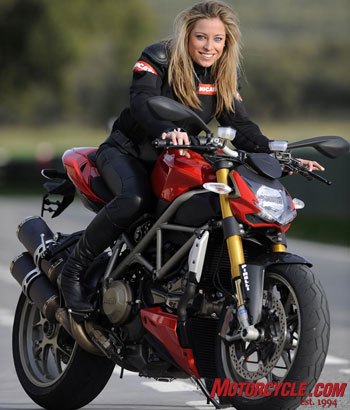

























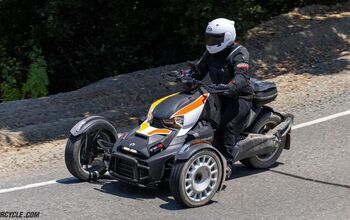




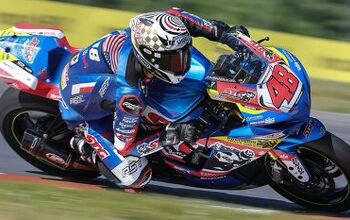
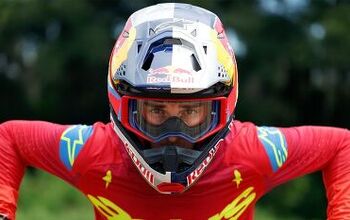

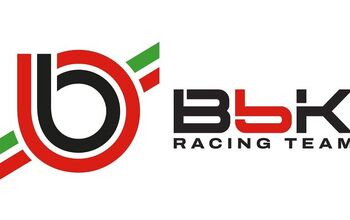

Comments
Join the conversation